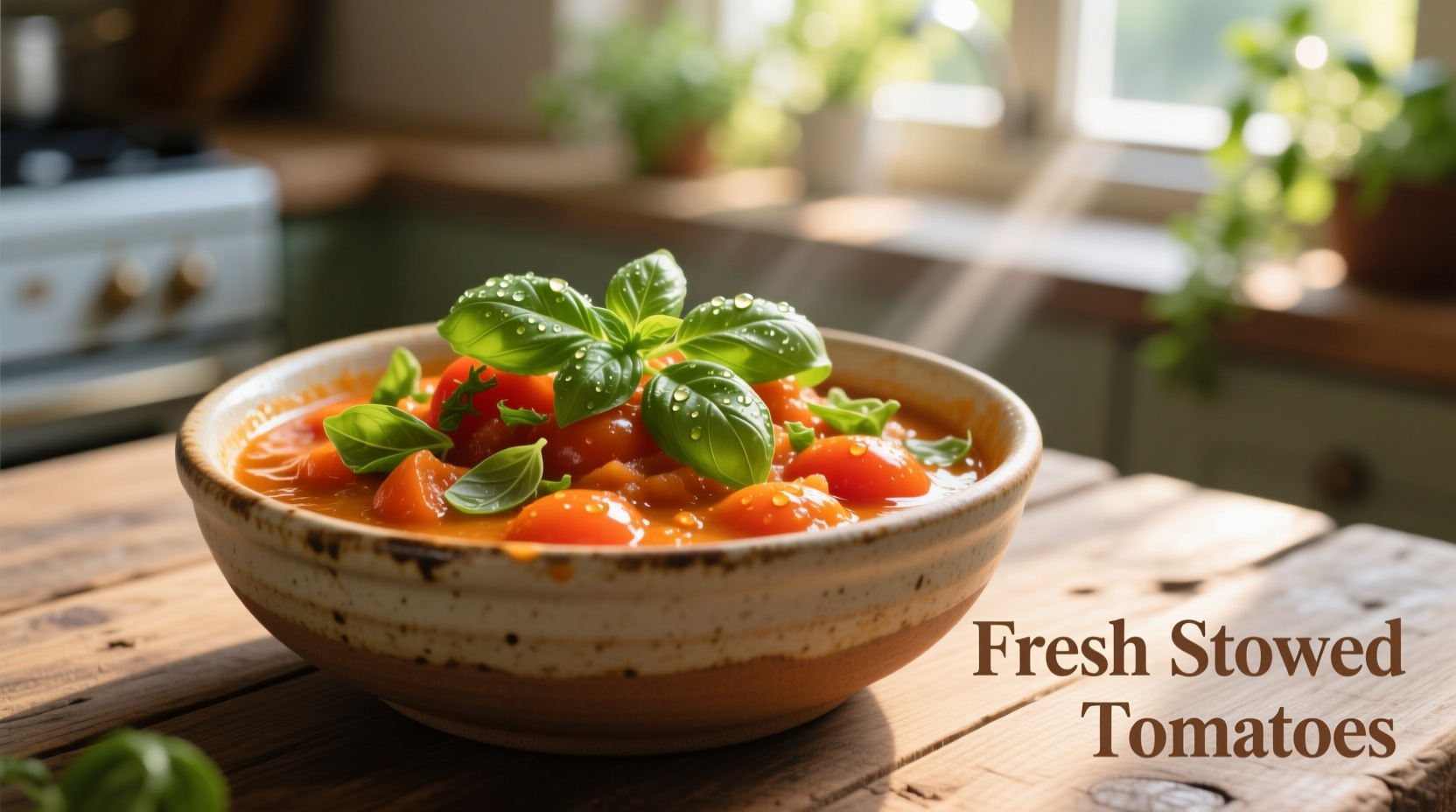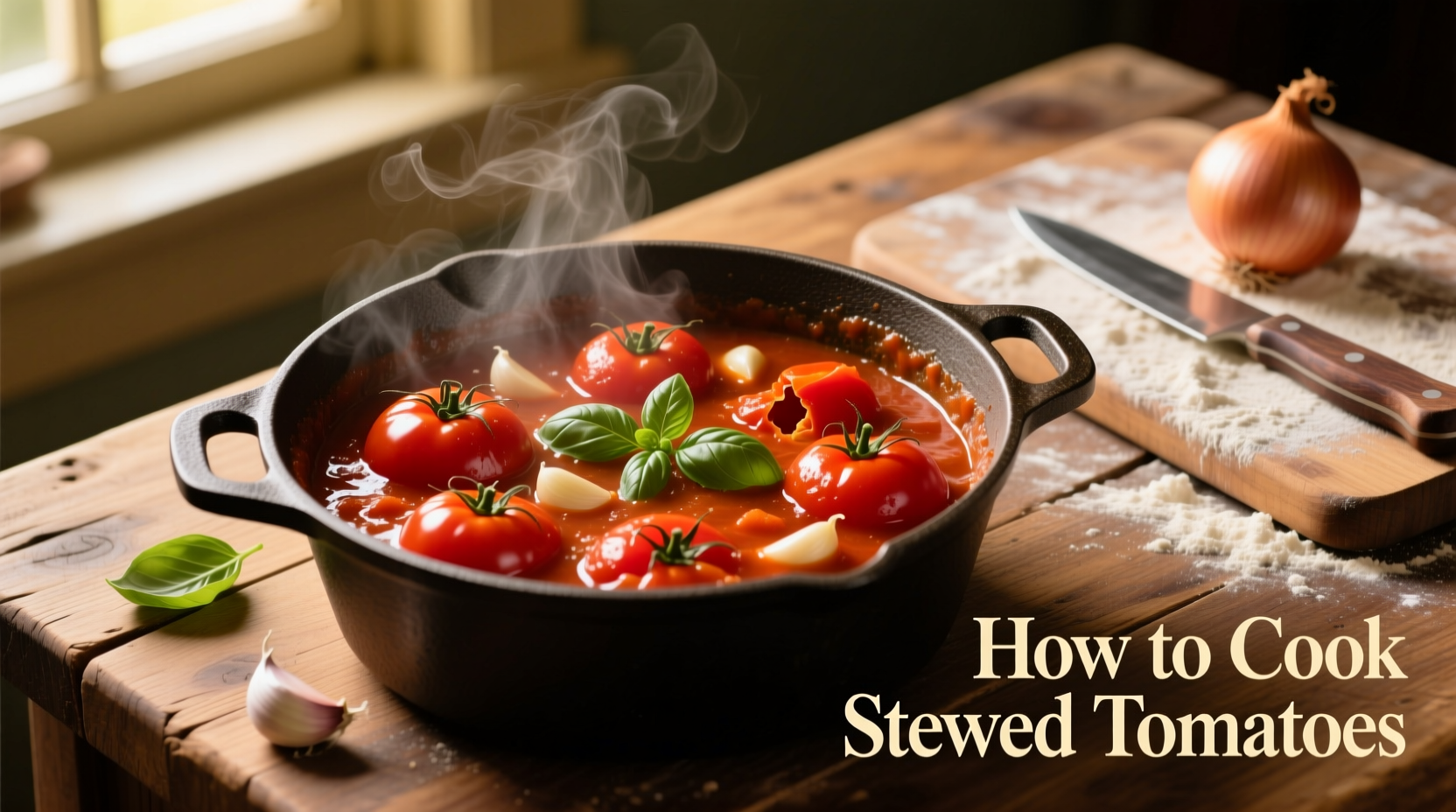Learn how to cook perfect stewed tomatoes in just 30 minutes with this simple recipe. You'll need fresh tomatoes, olive oil, garlic, onions, and basic seasonings. The key is slow simmering to develop rich flavor while maintaining texture—never boil vigorously. This method yields tender tomatoes with a balanced sweet-tart sauce ideal for pasta, sandwiches, or as a side dish.
Stewed tomatoes transform humble ingredients into a versatile culinary staple that elevates countless dishes. Whether you're preparing a quick weeknight meal or crafting something special, this foundational technique delivers restaurant-quality results at home. As a chef who's cooked in both Michelin-starred kitchens and family kitchens, I've perfected this method through thousands of repetitions—understanding exactly how heat, timing, and ingredient ratios affect the final product.
Why This Stewed Tomatoes Recipe Works
Many home cooks struggle with watery or bland stewed tomatoes because they rush the process or use improper techniques. The secret lies in controlled moisture reduction and layering flavors gradually. Unlike canned versions, homemade stewed tomatoes offer brighter flavor and better texture control. This recipe eliminates common pitfalls like:
- Excess liquid that dilutes flavor
- Mushy texture from overcooking
- Unbalanced acidity
- Garlic that burns before flavors develop
Food science confirms that slow simmering (below 180°F/82°C) preserves tomato integrity while allowing flavors to meld—critical for achieving that perfect tender-but-intact texture.
Essential Ingredients and Selection Guide
The quality of your ingredients directly impacts the final dish. Here's what to look for:
| Tomato Variety | Best For | Flavor Profile | Texture When Stewed |
|---|---|---|---|
| Roma | All-purpose stewing | Balanced sweet-tart | Firm, holds shape |
| Vine-ripened | Summer batches | Bright acidity | Slightly softer |
| Heirloom | Special occasions | Complex, floral notes | Delicate, breaks down faster |
Core ingredients for 4 servings:
- 2 lbs (900g) fresh tomatoes, cored and quartered
- 3 tbsp extra-virgin olive oil
- 1 medium yellow onion, finely diced
- 3 garlic cloves, minced
- 1 tsp sugar (balances acidity)
- ½ cup fresh basil, chopped
- Salt and freshly ground black pepper to taste
- Optional: 1 tbsp tomato paste for richer color
Pro tip: When tomatoes aren't in season, high-quality canned San Marzano tomatoes make an excellent substitute. The USDA confirms canned tomatoes retain comparable lycopene levels to fresh when processed properly.
Equipment You'll Need
- Heavy-bottomed saucepan or Dutch oven (ensures even heat distribution)
- Wooden spoon (won't scratch cookware)
- Microplane grater (for garlic if not mincing)
- Slotted spoon (for removing tomatoes if needed)
Step-by-Step Cooking Process
- Prep ingredients: Core tomatoes and cut into uniform quarters. Finely dice onion and mince garlic. Uniform sizing ensures even cooking.
- Sauté aromatics: Heat olive oil over medium-low heat. Add onions and cook until translucent (5-7 minutes). Add garlic and cook 1 minute until fragrant—never let garlic brown.
- Build flavor foundation: If using tomato paste, add now and cook 2 minutes to caramelize slightly. This step develops deeper flavor compounds according to food chemistry principles.
- Add tomatoes: Gently fold in tomatoes with sugar, ½ tsp salt, and pepper. Stir just enough to combine—excessive stirring breaks tomatoes.
- Simmer gently: Reduce heat to low. Partially cover and simmer 20-25 minutes. Stir only when necessary. The ideal simmer shows small bubbles breaking the surface every 5-10 seconds.
- Finish: Remove lid for last 5 minutes to thicken slightly. Stir in fresh basil. Taste and adjust seasoning.

Troubleshooting Common Issues
Even experienced cooks encounter these challenges. Here's how to fix them:
- Too watery: Remove tomatoes with slotted spoon, increase heat to medium, and reduce liquid by half before returning tomatoes.
- Too acidic: Add ¼ tsp baking soda (neutralizes acid without altering flavor) or extra sugar.
- Burnt bottom: Immediately transfer to clean pot. Scrape burnt bits from original pot—they'll impart bitter flavor.
- Mushy texture: You likely used overripe tomatoes or simmered too vigorously. Next time, use firmer tomatoes and maintain true simmer.
When to Use This Method (and When Not To)
This technique shines in these scenarios:
- When you need a quick sauce base (ready in 30 minutes)
- For dishes requiring distinct tomato pieces (unlike blended sauces)
- When serving immediately (texture degrades after refrigeration)
Avoid this method when:
- Preparing for canning (requires specific acidity levels)
- Creating smooth sauces (use blended tomatoes instead)
- Using unripe tomatoes (they won't develop proper sweetness)
Food safety experts at the National Center for Home Food Preservation note that stewed tomatoes for immediate consumption have different requirements than canned versions—this recipe follows safe practices for fresh preparation.
Serving and Storage Recommendations
Best served: Over polenta, with crusty bread, or as a side to grilled meats. Pairs exceptionally well with fresh mozzarella.
Storage:
- Refrigerate in airtight container for up to 4 days
- Freeze for up to 3 months (thaw overnight in refrigerator)
- Never can this recipe—it lacks required acidity for safe canning
When reheating, add a splash of water or olive oil to refresh texture. The USDA recommends reheating leftovers to 165°F (74°C) for food safety.
Frequently Asked Questions
Can I use canned tomatoes instead of fresh?
Yes, high-quality canned San Marzano tomatoes work well. Use one 28-ounce can with juices. Reduce simmer time to 15 minutes since canned tomatoes are already partially cooked. Drain excess liquid if needed during cooking.
Why did my stewed tomatoes turn out watery?
This happens when tomatoes release too much liquid during cooking. To fix: 1) Use firmer tomato varieties like Roma, 2) Simmer uncovered for the last 5-10 minutes to evaporate excess liquid, or 3) Remove tomatoes temporarily and reduce the liquid by half before returning them.
How can I make stewed tomatoes less acidic?
Add ¼-½ teaspoon sugar during cooking to balance acidity. For a more sophisticated approach, incorporate 1-2 finely diced carrots with the onions—they naturally sweeten the sauce as they cook. Avoid baking soda unless absolutely necessary, as it can alter flavor.
Can I freeze stewed tomatoes?
Yes, stewed tomatoes freeze well for up to 3 months. Cool completely before transferring to freezer-safe containers, leaving 1-inch headspace for expansion. Thaw overnight in the refrigerator before reheating. Note that texture may soften slightly after freezing.











 浙公网安备
33010002000092号
浙公网安备
33010002000092号 浙B2-20120091-4
浙B2-20120091-4